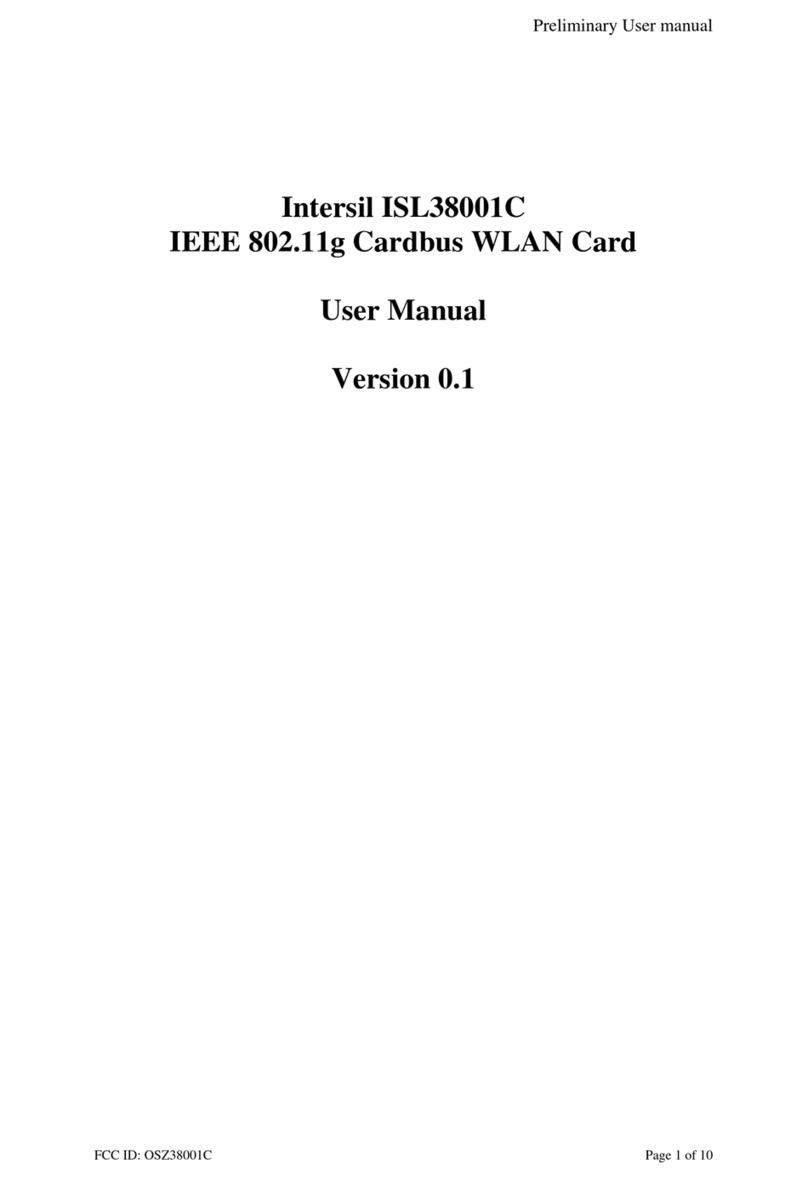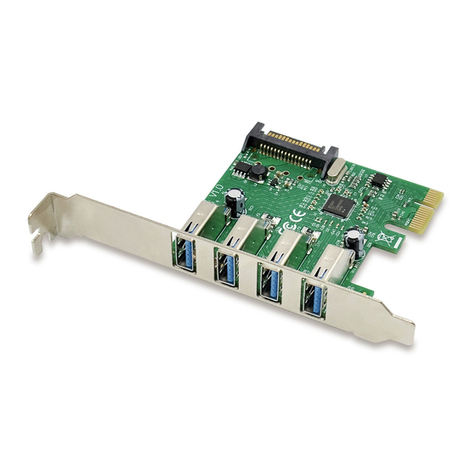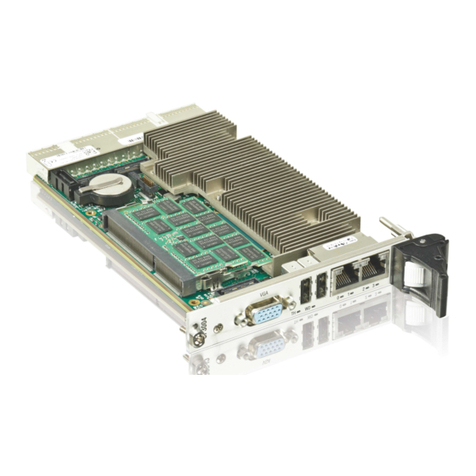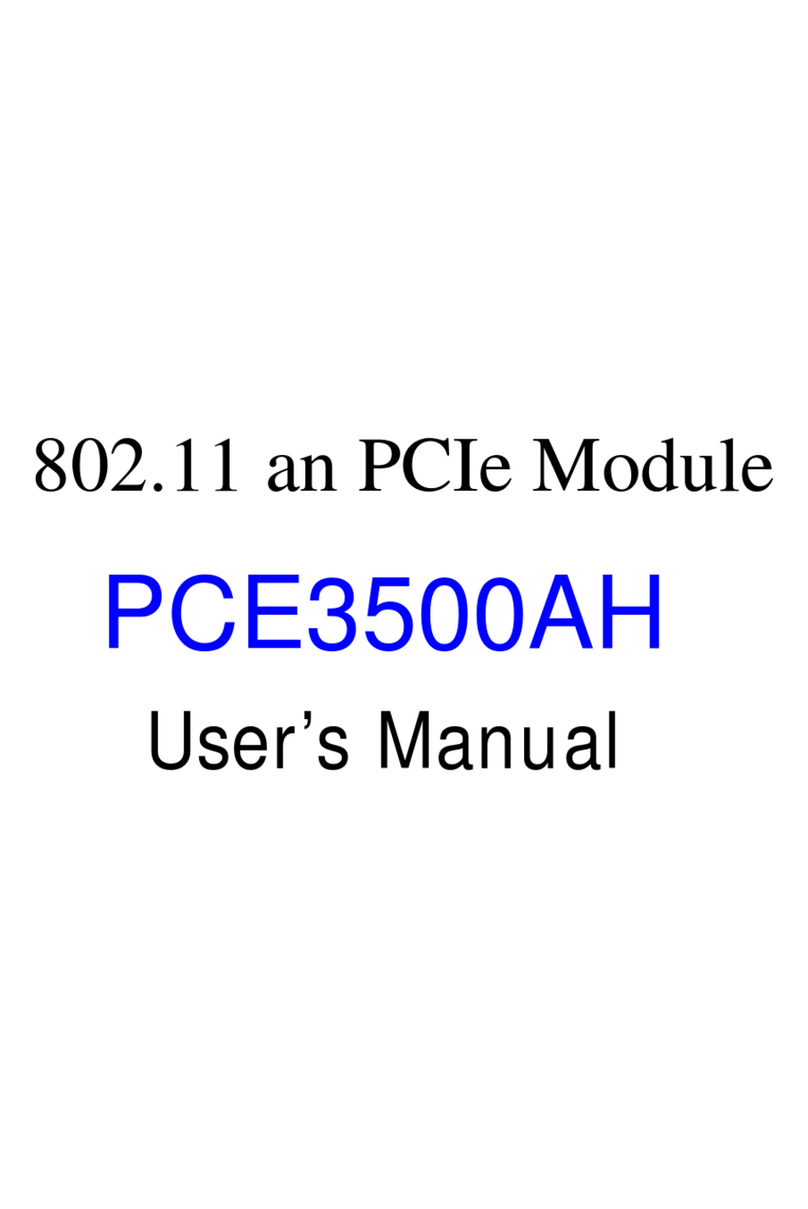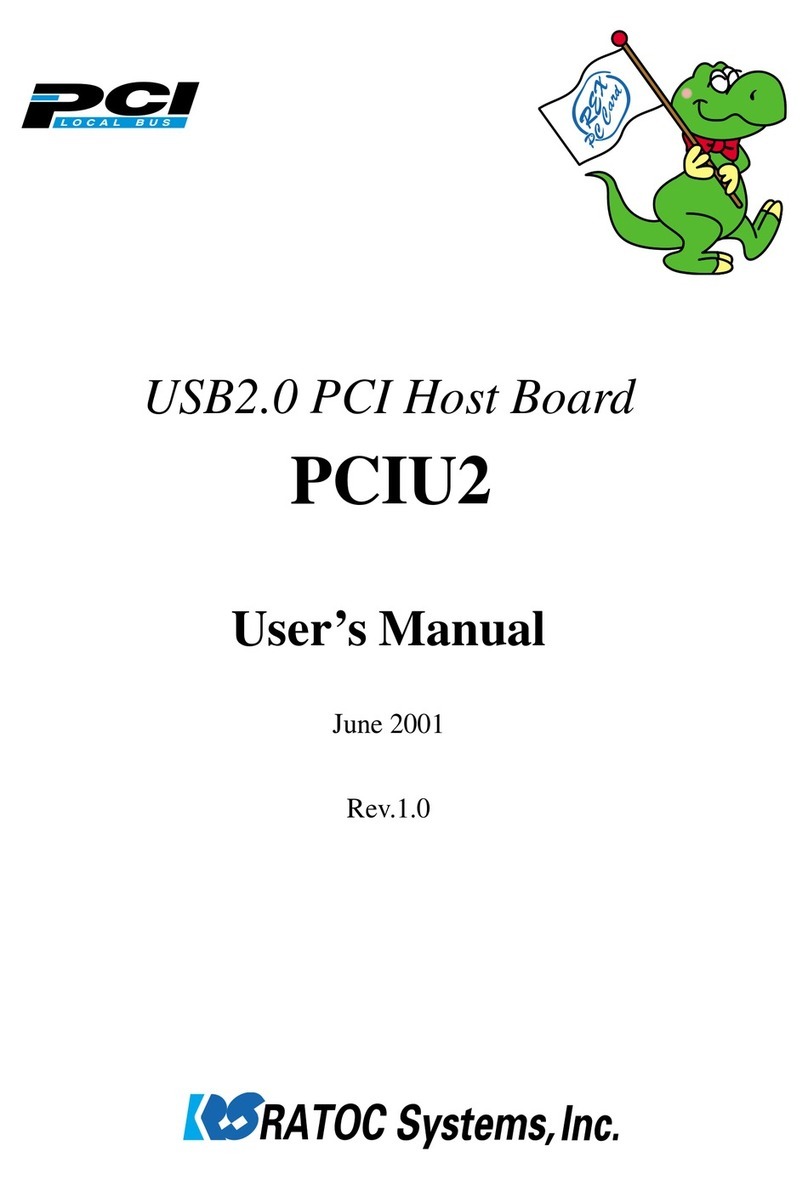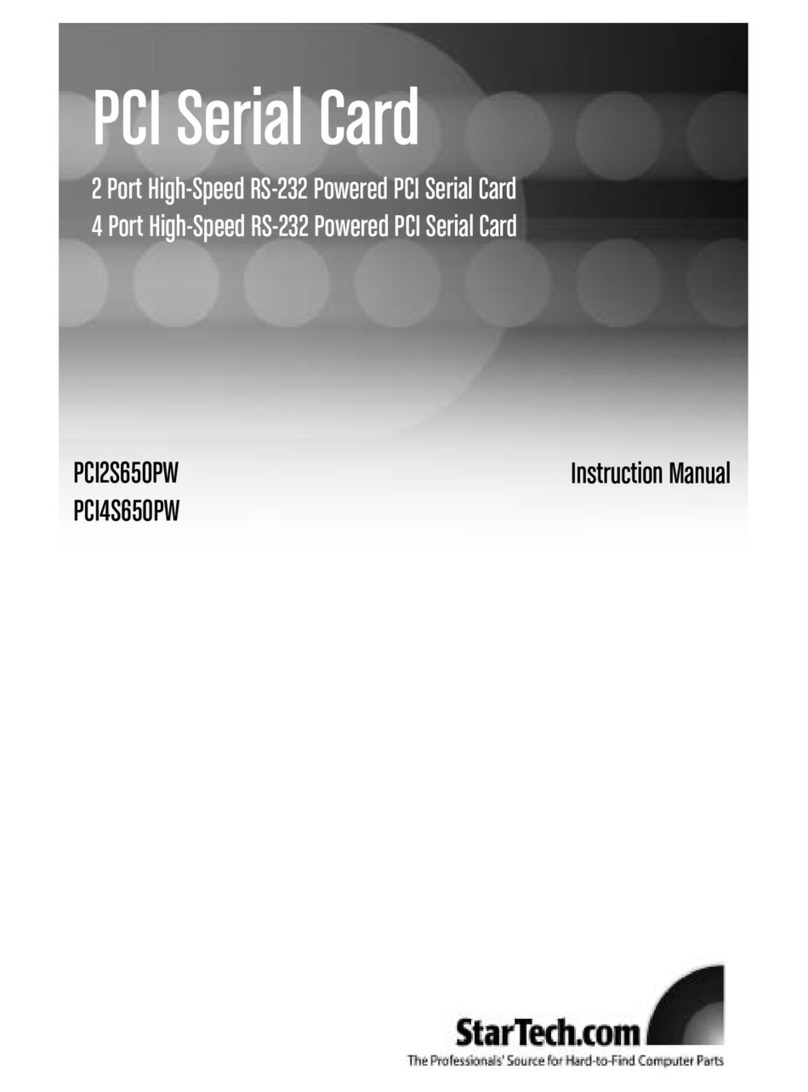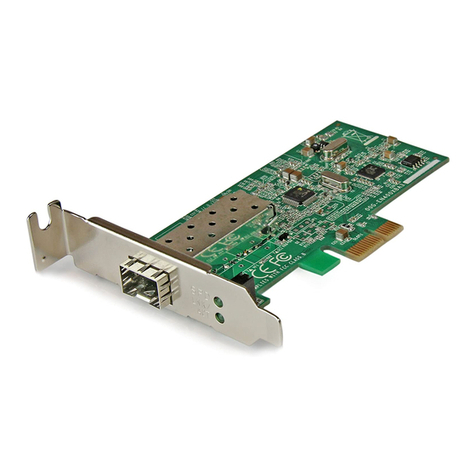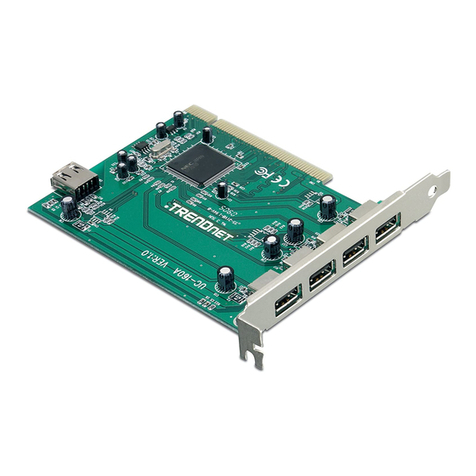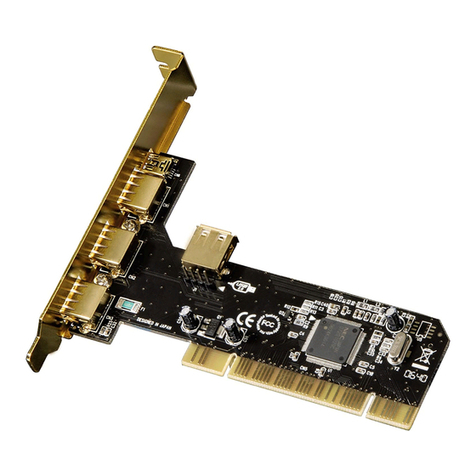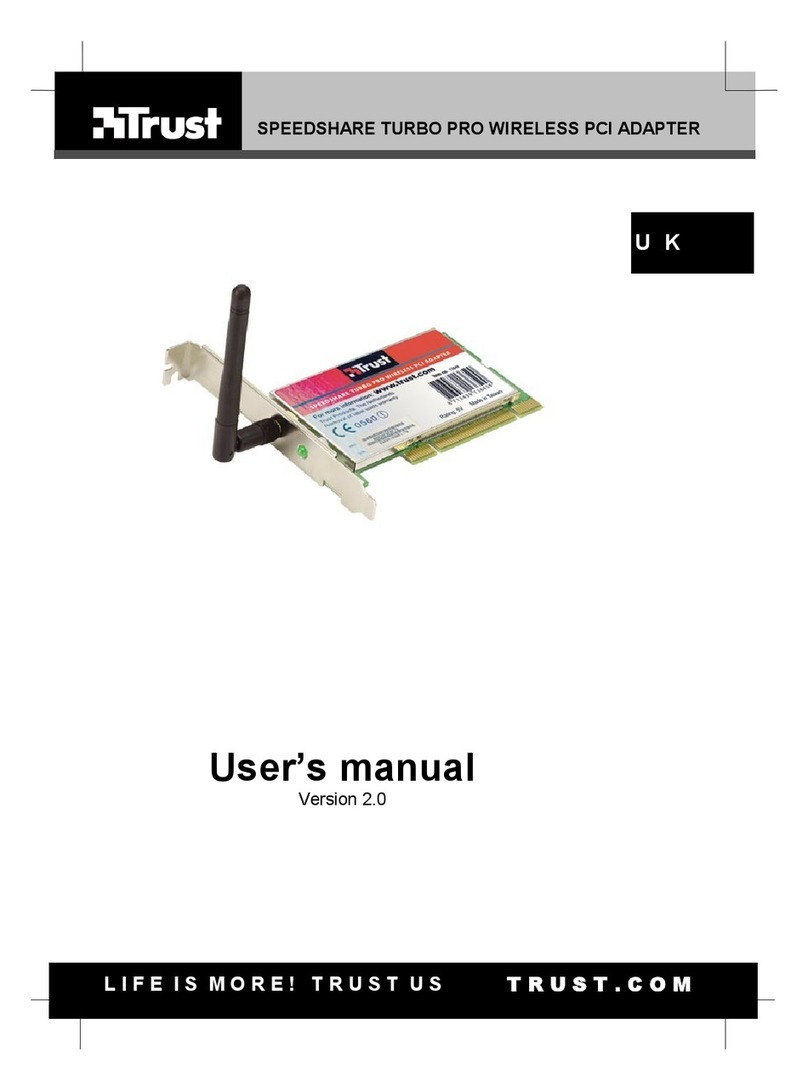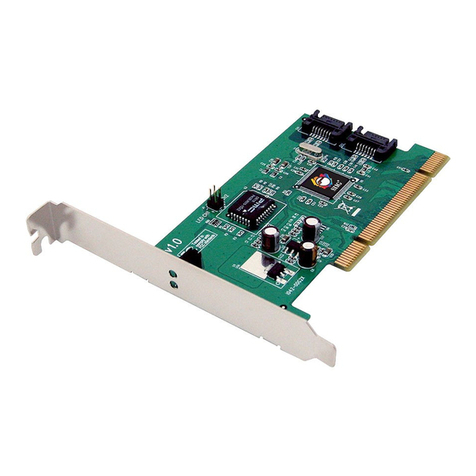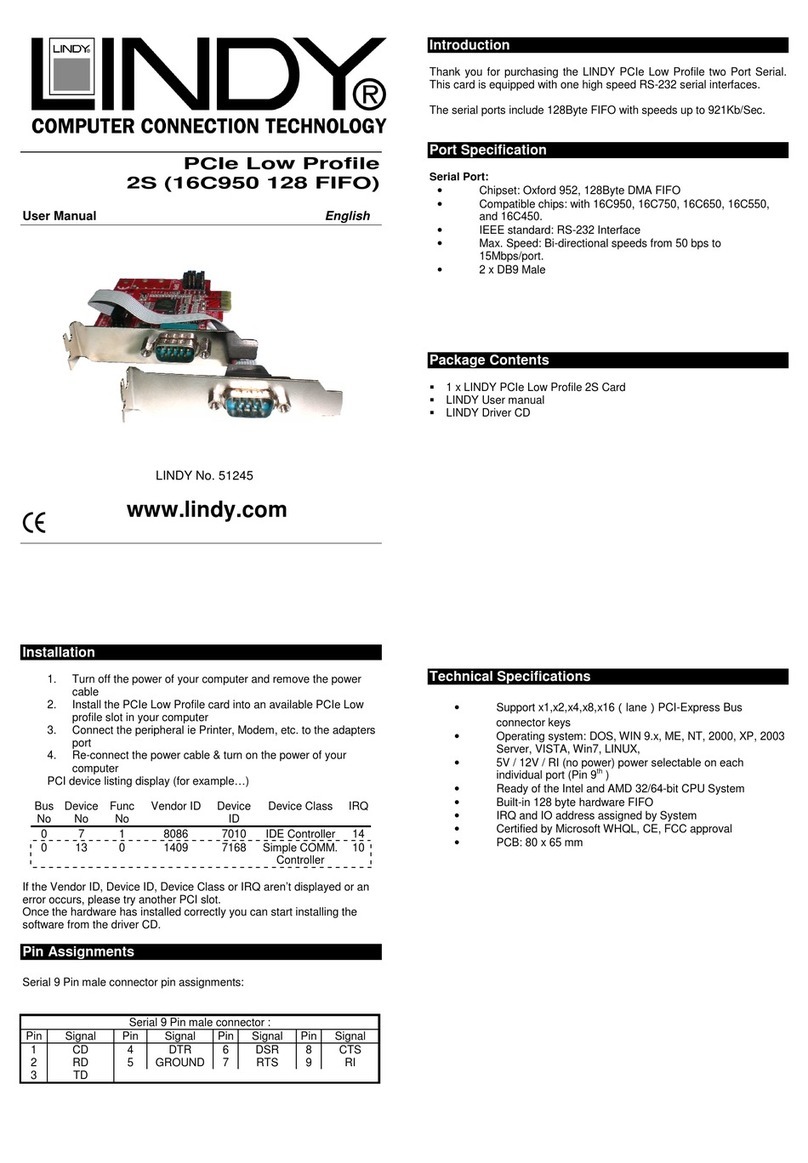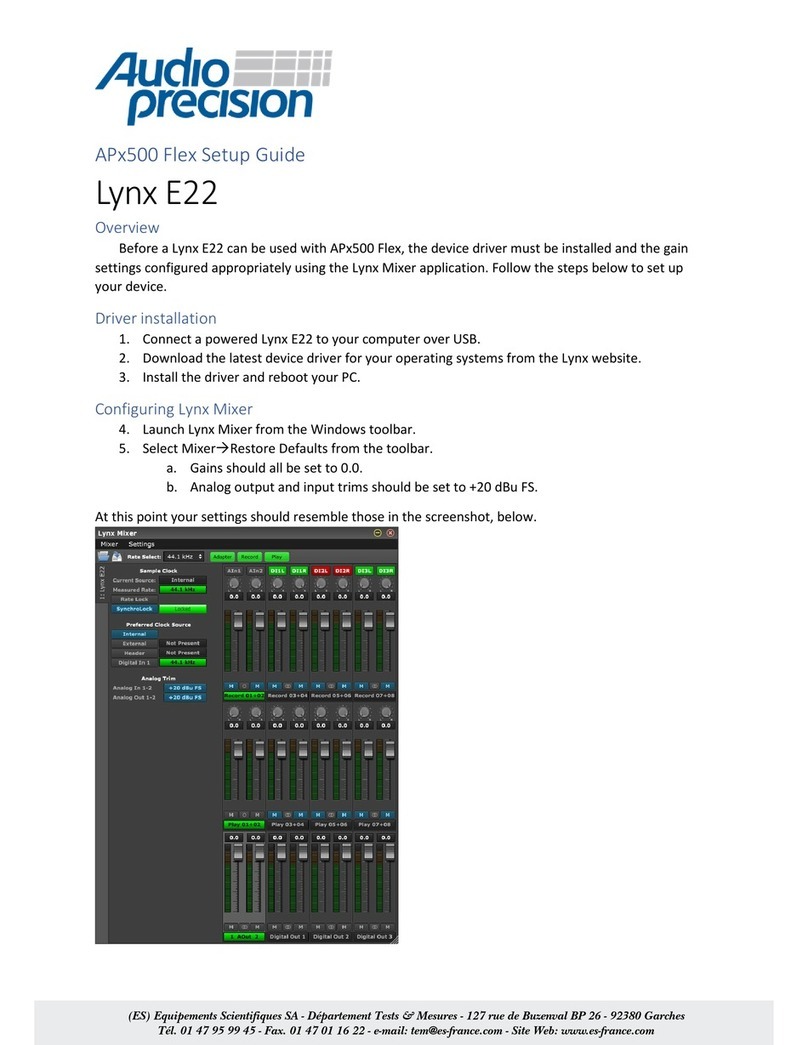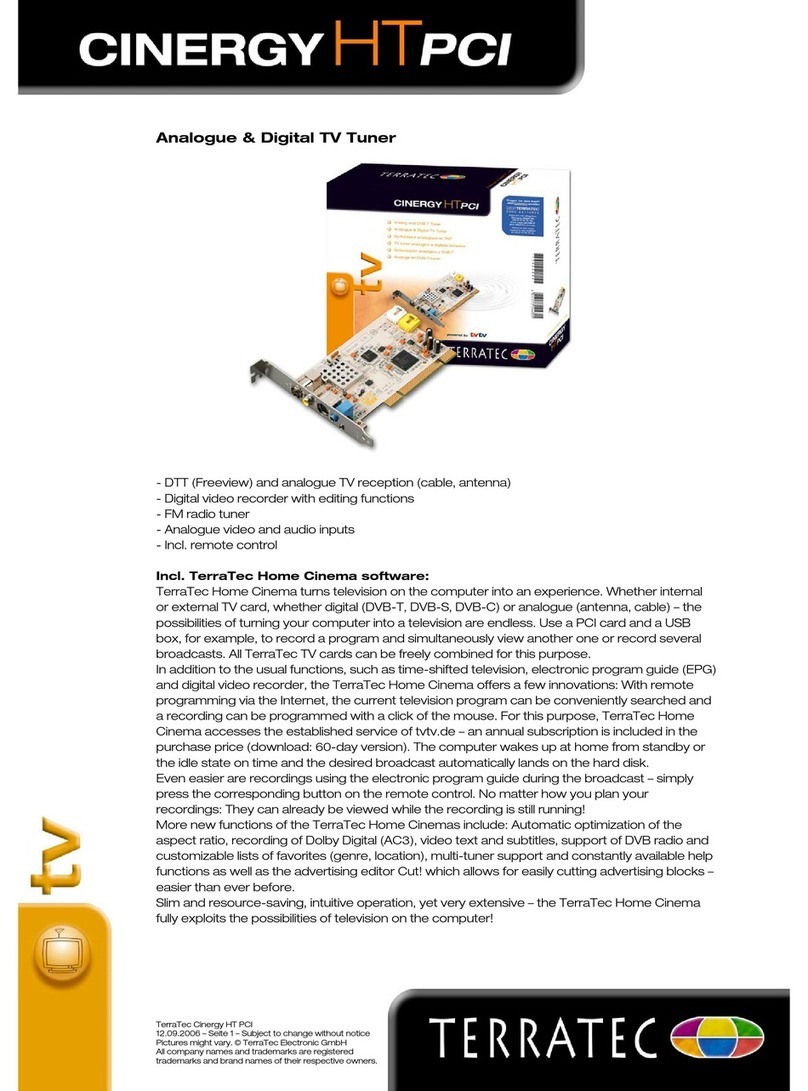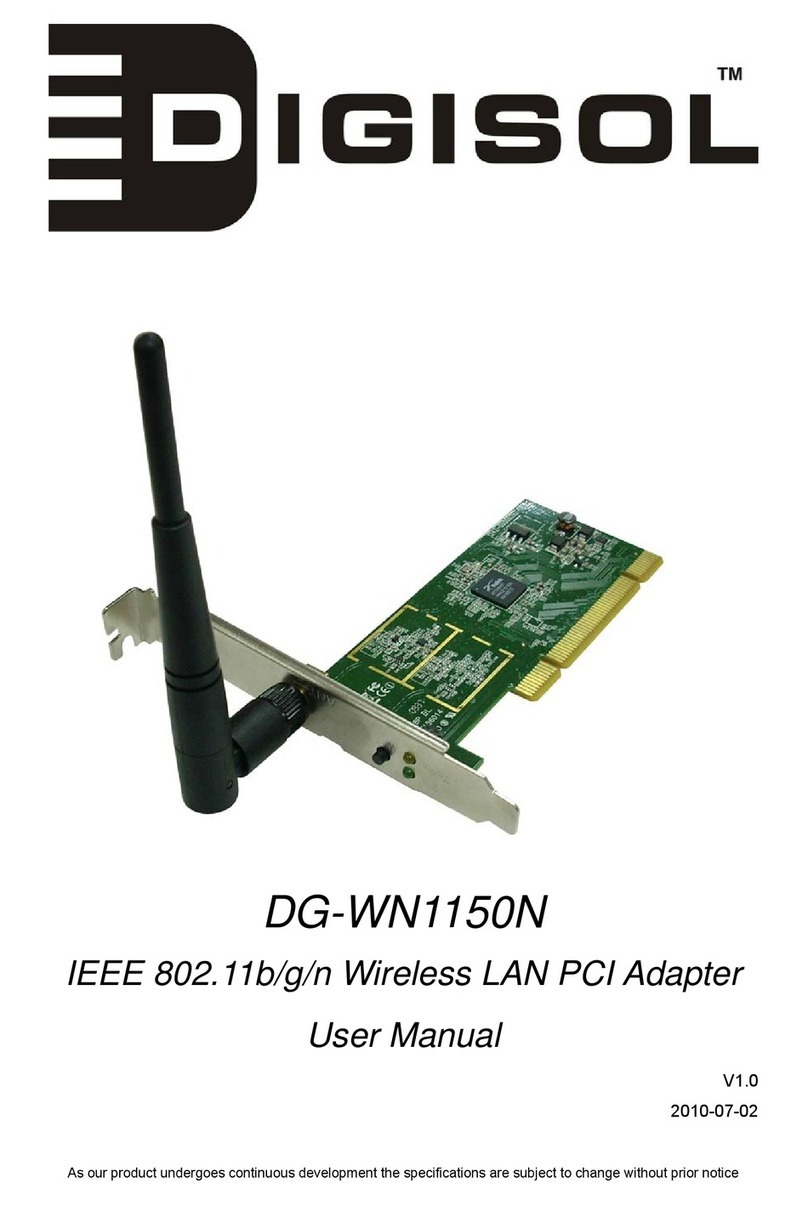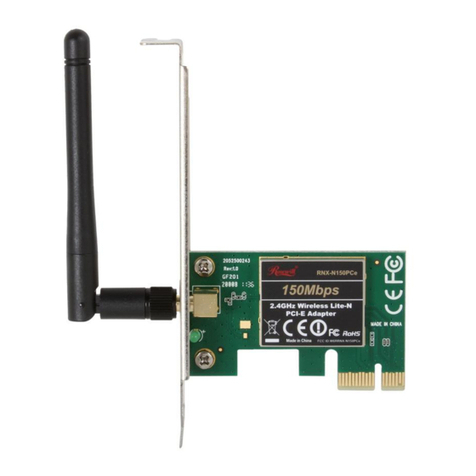BlueChip PCI-PIO User manual

PCI-PIO
User Manual
Document Part N°0127-0187
Document Reference PCI-PIO\..\0127-0187.doc
Document Issue Level 1.0
Manual covers PCBs identified PCI-PIO Issue. 2.x (x is any digit)
All rights reserved. No part of this publication may be reproduced, stored in any retrieval system, or
transmitted, in any form or by any means, electronic, mechanical, photocopied, recorded or otherwise,
without the prior permission, in writing, from the publisher.
Information offered in this manual is correct at the time of printing. The publisher accepts no
responsibility for any inaccuracies. This information is subject to change without notice.
All trademarks and registered names acknowledged.

Amendment History
Issue
Level Issue
Date Author Amendment Details
0.1 13/10/97 PDJ First Issue as P/N 127-187
0.2 4/12/97 PDJ On board oscillator changes from 1MHz. to
4MHz. Add description of DOS program
0.3 20/01/98 EGW Refer to readme.txt file. Amendments to
CISReg A & B
1.0 20/03/98 SEJ Update headers and footers

Contents
Blue Chip Technology Ltd. 01270187.doc
INTRODUCTION.......................................................................................1
ABOUT THE MANUAL............................................................................2
INSTALLING THE PCI-PIO.....................................................................3
CONNECTION DETAILS.........................................................................4
Suitable Interface Signal Types.................................................................5
PROGRAMMING DETAILS ....................................................................6
Address Map.............................................................................................7
i8255 / µPD71055 PIO..............................................................................8
i8254 / µPD71054 Counter / Timer ...........................................................9
Counter / Timer Modes.............................................................................9
Counter Control......................................................................................11
Interrupt Selection ..................................................................................13
TECHNICAL SPECIFICATIONS...........................................................15
Electromagnetic Compatibility (EMC)....................................................16
PCB LAYOUT DIAGRAM......................................................................18

Introduction Page 1
Blue Chip Technology Ltd. 01270187.doc Page 1
INTRODUCTION
The PCI-PIO is a PCI-compatible half-card which provides digital input/outputs
and counter/timers.
There are 48 TTL-compatible programmable digital input/outputs available
from the board. If the controlling devices are used in handshake mode, the
handshake lines are available as interrupt sources.
There are also three programmable counter/timers, the enable and clock inputs
being available externally, if required , and the outputs being accessible
externally or as interrupt sources. A 4MHz crystal oscillator is available on
board to allow the counter/timers to act as accurate timebases.
All input/output lines are available at an industry standard 50 way D-type plug
connector.
One PCI interrupt line may be selectively driven by the seven interrupt sources
on the board, the interrupting source being readily identified by the board.
The PCI-PIO is intended to be installed with the minimum of user interaction.
The board is configured by the system BIOS and by the application drivers and
no on-board links are required to select functionality.

Page 2About the Manual
Page 201270187.doc Blue Chip Technology Ltd.
ABOUT THE MANUAL
This manual is organised into four chapters. Each chapter covers a different
aspect of using the PCI-PIO. In order to get the best results from the product,
the user is urged to read all chapters, paying particular note to Chapter 1 which
deals with the initial installation of the card.
Chapter 1 Explains how to install the card in your computer.
Chapter 2 Details the connections to and from the card.
Chapter 3 Gives details of the card’s address mapping and internal register
details allowing the user to write custom software to control the
card.
Chapter 4 Presents the card’s technical specification. Use this section to
determine the card’s suitability for a particular application
This manual describes the complete hardware functionality of the PCI-PIO
board. All the functions may not necessarily be supported by the current release
of the NT driver and DLL set.

Chapter 1 Installation Page 3
Blue Chip Technology Ltd. 01270187.doc Page 3
CHAPTER 1
INSTALLING THE PCI-PIO
The card is installed by removing the cover of the host computer and inserting
the card into a free PCI slot. The rear panel of the card should then be secured
to the rear panel of the host computer with the screw supplied with the
computer.
When the computer is switched on, the BIOS will detect the presence of the
card and will allocate it with a base address and an interrupt. These
parameters may then be used to configure application software to access the
card.
If the card is to be directly accessed by a user’s application, it will be necessary
for the application to determine where the BIOS has located the card.
To this end a software function has been provided. Refer to the “Readme.txt”
file on the supplied disk for details.

Page 4Connection Details Chapter 2
Page 401270187.doc Blue Chip Technology Ltd.
CHAPTER 2
CONNECTION DETAILS
The following table refers to the 50 way D-type plug at the rear of the card.
PIN USAGE PIN USAGE PIN USAGE
1PIO1 port A, b0 (PAA0) 18 PIO1 port C, b1 (PAC1) 34 PIO2 port B, b1 (PBB1)
or Counter I/O
2PIO1 port A, b1 (PAA1) 19 PIO1 port C, b2 (PAC2) 35 PIO2 port B, b2 (PBB2)
or Counter I/O
3PIO1 port A, b2 (PAA2) 20 PIO1 port C, b3 (PAC3)
and/or interrupt source
or Counter I/O
36 PIO2 port B, b3 (PBB3)
4PIO1 port A, b3 (PAA3) 21 PIO1 port C, b4 (PAC4) 37 PIO2 port B, b4 (PBB4)
5PIO1 port A, b4 (PAA4) 22 PIO1 port C, b5 (PAC5) 38 PIO2 port B, b5 (PBB5)
6PIO1 port A, b5 (PAA5) 23 PIO1 port C, b6 (PAC6) 39 PIO2 port B, b6 (PBB6)
7PIO1 port A, b6 (PAA6) 24 PIO1 port C, b7 (PAC7) 40 PIO2 port B, b7 (PBB7)
8PIO1 port A, b7 (PAA7) 25 PIO2 port A, b0 (PBA0) 41 PIO2 port C, b0 (PBC0)
and/or interrupt source
or Counter I/O
9PIO1 port B, b0 (PAB0) 26 PIO2 port A, b1 (PBA1) 42 PIO2 port C, b1 (PBC1)
10 PIO1 port B, b1 (PAB1) 27 PIO2 port A, b2 (PBA2) 43 PIO2 port C, b2 (PBC2)
11 PIO1 port B, b2 (PAB2) 28 PIO2 port A, b3 (PBA3) 44 PIO2 port C, b3 (PBC3)
and/or interrupt source
or Counter I/O
12 PIO1 port B, b3 (PAB3) 29 PIO2 port A, b4 (PBA4) 45 PIO2 port C, b4 (PBC4)
13 PIO1 port B, b4 (PAB4) 30 PIO2 port A, b5 (PBA5) 46 PIO2 port C, b5 (PBC5)
14 PIO1 port B, b5 (PAB5) 31 PIO2 port A, b6 (PBA6) 47 PIO2 port C, b6 (PBC6)
15 PIO1 port B, b6 (PAB6) 32 PIO2 port A, b7 (PBA7) 48 PIO2 port C, b7 (PBC7)
16 PIO1 port B, b7 (PAB7) 33 PIO2 port B, b0 (PBB0)
or Counter I/O 49 Digital Ground
17 PIO1 port C, b0 (PAC0)
and/or Interrupt source
or Counter I/O
50 Digital Ground

Chapter 2 Connection Details Page 5
Blue Chip Technology Ltd. 01270187.doc Page 5
Suitable Interface Signal Types
The input and output signals for the PCI-PIO parallel ports and counter/timers
are strictly digital TTL levels with voltage limits of zero volts for a logic low
and +5 volts for a logic high. Voltages outside these limits may cause damage to
the card. The output current drive capability makes the card suitable for
connection to TTL logic type circuits. The PCI-PIO is compatible with most
types of TTL logic. Because the lines are TTL it is recommended that input
signal lines do not exceed 2 metres in length. Operation at longer lengths may
cause drive level problems.
Driving conventional relay coils is not recommended without external
protection even if the coil current required is less than the PCI-PIO can provide.
Relay coils are inductive and as such can generate large flyback voltages when
de-energised which will destroy the device outputs.

Page 6Programming Details Chapter 3
Page 601270187.doc Blue Chip Technology Ltd.
CHAPTER 3
PROGRAMMING DETAILS
This chapter provides details of the cards internal registers.
The board’s input/output facilities are provided by two Intel i8255, or NEC
µPD71055 PIO devices (compatible with the Intel part) and an Intel i8254, or
NEC µPD71054 Counter/timer (compatible with the Intel part).
Each PIO provides 24 programmable digital I/O channels. It is suitable for
sensing the presence of, or driving TTL connections only. These connections
should be kept as short as possible, less than 2 metres is recommended.
Each PIO appears to the PC as four I/O addressable registers. The first three
registers control the I/O ports which can be set as input or output by writing
suitable codes to the fourth Control Port.
Three modes of operation are available within the device:-
Mode 0 is for general purpose I/O and allows all three ports to be configured as
either inputs or outputs.
Mode 1 is for full duplex parallel communication and allows one port to be
configured for inputs, another for outputs and the third as transfer handshake
lines and interrupt sources.
Mode 2 is for half duplex parallel data communication, and allows one port to
be configured for data transfer I/O, a second as transfer handshake lines and an
interrupt source, and the third as a general purpose I/O port (similar to mode 0).
For mode 0, a summary of the codes required to change the operation of the
ports are given later. A typical sequence of events to use this feature would be :
• Decide on the mix of input/outputs required and write the appropriate
code to the Control Register.
• Read from the selected input port or write to the selected output port.

Chapter 3 Programming Details Page 7
Blue Chip Technology Ltd. 01270187.doc Page 7
The 8254 contains three 16-bit Counter/timers each of which has separate clock
and enable inputs and an output, all of which are TTL compatible. Connections
to these signals should be kept as short as possible, less than 2 metres is
recommended.
The 8254 appears to the PC as four ports. The first three are count registers for
the three counter/timers, and the fourth is a Control Register which configures
the mode of operation of the three counters. These are accessed at the addresses
shown in the map below.
A summary of the codes required to change the port operations are given later.
Address Map
The address map for the PCI-PIO occupies a 16-byte block of addresses.
All the following addresses are relative to PCI base address register 2, located at
address 18 (hex) in the PCI configuration space.
ADDRESS FUNCTION READ/
WRITE
Base + 0 PIO 1, Port A Input/Output Register (Channel 0 to 7) R/W
Base + 1 PIO 1, Port B Input/Output Register (Channel 8 to 15) R/W
Base +2 PIO 1, Port C Input/Output Register (Channel 16 to 23) R/W
Base + 3 PIO 1, Control Register W
Base + 4 PIO 2, Port A Input/Output Register (Channel 24 to 31) R/W
Base + 5 PIO 2, Port B Input/Output Register (Channel 32 to 39) R/W
Base + 6 PIO 2, Port C Input/Output Register (Channel 40 to 47) R/W
Base + 7 PIO 2, Control Register W
Base + 8 Counter/timer 0 Count Register R/W
Base + 9 Counter/timer 1 Count Register R/W
Base + 10 Counter/timer 2 Count Register R/W
Base + 11 Counter/timer Control Register W
Base + 12 Interrupt enable register R/W
Base + 13 Interrupt status register R
Base + 14 Counter control register A R/W
Base + 15 Counter control register B R/W

Page 8Programming Details Chapter 3
Page 801270187.doc Blue Chip Technology Ltd.
The i8255 / µPD71055 PIO and i8254 / µPD71054 Counter/timer ICs are
complex devices. For full details on how to program these devices, refer to the
manufacturer’s data sheets. Presented here is a brief summary of the main
features of each.
i8255 / µPD71055 PIO
The PIO chip can operate in one of three modes.
The first (Mode 0) provides for simple inputs and outputs for three, 8-bit ports.
Data is written to or read from a specified port (A, B, or C) without the use of
handshaking. The following table gives a summary of the most commonly used
control words which must be written to the control port to configure the i8255 /
µPD71055 I/O ports in Mode 0.
CONTROL
WORD (hex) CONTROL
WORD
(decimal)
SET ALL
of PORT
A as
SET ALL
of PORT
B as
SET HIGH
4 BITS of
C as
SET LOW
4 BITS of
C as
80 128 Output Output Output Output
81 129 Output Output Output Input
82 130 Output Input Output Output
83 131 Output Input Output Input
88 136 Output Output Input Output
89 137 Output Output Input Input
8A 138 Output Input Input Output
8B 139 Output Input Input Input
90 144 Input Output Output Output
91 145 Input Output Output Input
92 146 Input Input Output Output
93 147 Input Input Output Input
98 152 Input Output Input Output
99 153 Input Output Input Input
9A 154 Input Input Input Output
9B 155 Input Input Input Input
Mode 1 enables the transfer of data to or from a specified 8 bit port (A or B) in
conjunction with strobes or handshaking signals on port C. These handshaking
signals may be used to drive interrupt channels if required.

Chapter 3 Programming Details Page 9
Blue Chip Technology Ltd. 01270187.doc Page 9
In Mode 2, data is transferred via one bi-directional 8 bit port (A) with
handshaking (port C). These handshaking signals may be used to drive interrupt
channels if required.
Refer to the i8255 or µPD71055 data sheet for full details of the settings and use
of Modes 1 and 2.
i8254 / µPD71054 Counter / Timer
The counter/timer circuit contains three independent 16-bit counters which may
be operated in a variety of modes. There are five basic modes of operation with
each mode providing a different output signal. Presented here is a brief
summary of some of the modes possible by programming the counter / timer’s
internal registers.
All three counter/timers may be operated independently, with separate clocks
and enable controls.
Counter 0, Counter 1 and Counter 2 may be connected in series. Counter 0
output to Counter 1 clock input and/or Counter 1 output to Counter 2 clock
input, to allow the facility of generating very long delay periods.
The outputs from any counter/timer may be configured to generate an interrupt
when going high or low, and may also be made accessible on the back panel
connector.
The clock and enable inputs of the counter/timers may also be made accessible
on the back panel connector.
Counter / Timer Modes
The following modes of operation exist by programming the control register
within the i8254 / µPD71054. N.B. The interrupts may be generated when the
Counter/timer outputs go low or high, selected by bits in the counter control
registers.

Page 10 Programming Details Chapter 3
Page 10 01270187.doc Blue Chip Technology Ltd.
Mode 0
When programmed, the output pin will go LOW. When the counter decrements
from the value loaded into the count registers to zero, the output pin will go
HIGH. It will remain high until the count is re-programmed into the count
registers.
Mode 1
When the count registers are programmed the output pin will be HIGH. When
a LOW going signal is applied to the gate input, the count starts and the output
will fall LOW, returning HIGH at the end of the count.
Mode 2
This mode operates as a frequency divider. When programmed the output pin is
HIGH. When the count decrements to a value of 1 the output pin will go LOW
for ONE clock cycle only and then return HIGH. This cycle repeats
continuously without the need to re-program the count value.
Mode 3
When programmed the output pin will toggle each time the count register
decrements to its base level from the value programmed into it. If the count
value loaded is an odd number then the counter will reach zero before the output
pin toggles. This mode therefore acts as a frequency divider with an
approximate 1:1 mark-space ratio.
Mode 4
This mode is similar to mode 2 but the output pin pulses when the count reaches
zero instead of 1.
Mode 5
This mode is similar to mode 4 except that the count sequence is triggered by
the gate line.

Chapter 3 Programming Details Page 11
Blue Chip Technology Ltd. 01270187.doc Page 11
Counter Control
The control and output lines of the counter/timer may be accessed on the rear
panel connector by sacrificing some of the digital I/O lines.
The clock inputs of the i8254 counter/timer are selected using the Counter Input
Select Register A at Base + E (Hex), as shown below:-
Counter Input Select Register A (Base + E)
Bit no. Function
b7 Enable counter outputs such that PBB0 = Counter 2 output
PBB1 = Counter 0 output
PBB2 = Counter 1 output
b6 Counter 0 interrupt level:- 0 = Interrupt on counter out low
1 = Interrupt on counter out high
b5..b4 Counter 2 clock source:- 00 = 4 MHz oscillator
01 = PBB2 port line
10 = Counter 1 output
11 = PBC0 port line
b3..b2 Counter 1 clock source:- 00 = 4 MHz oscillator
01 = PBB1 port line
10 = Counter 0 output
11 = PAC3 port line
b1..b0 Counter 0 clock source:- 00 = 4 MHz oscillator
01 = PBB0 port line
10 = Counter 2 output
11 = PAC0 port line
If Bit b7 in the counter control register is set, then the counter outputs are
enabled onto port lines PBB0, PBB1 & PBB2, which connect to the 50 way
D-type connector. Consequently this port must be set as an input in the relevant
71055 device to avoid contention. This same condition applies to any port line
which is used for a counter/timer function.

Page 12 Programming Details Chapter 3
Page 12 01270187.doc Blue Chip Technology Ltd.
The enable inputs of the i8254 counter are selected using the Counter Input
Select Register B at Base + F (Hex), as shown below:-
Counter Input Select Register B (Base + F)
Bit no. Function
b7 Counter 2 interrupt level:- 0 = Interrupt on counter out low
1 = Interrupt on counter out high
b6 Counter 1 interrupt level:- 0 = Interrupt on counter out low
1 = Interrupt on counter out high
b5..b4 Counter 2 enable source:- 00 = Permanently enabled
01 = PBB1 port line
10 = PBC0 port line
11 = PBC3 port line
b3..b2 Counter 1 enable source:- 00 = Permanently enabled
01 = PBB0 port line
10 = PAC3 port line
11 = PBC0 port line
b1..b0 Counter 0 enable source:- 00 = Permanently enabled
01 = PBB2 port line
10 = PAC0 port line
11 = PAC3 port line
Notice that it is possible by judicious setting of Counter Input Registers A and
B, to set each timer/counter to operate with an external count input, enable and
counter output if required. For example it is possible to set Counter 0 to use
PBB0 as a count input, PBB2 as an enable input, and PBB1 as a count output.
Other combinations are possible, but because of the flexibility which is
permitted, care must be exercised to avoid conflicting uses of the same port
lines.

Chapter 3 Programming Details Page 13
Blue Chip Technology Ltd. 01270187.doc Page 13
Interrupt Selection
A total of seven sources of interrupt are available from the two PIO devices and
the counter/timers. These interrupts are summarised below:-
• INT1 (AC0) is available when PIO1 is operating in mode 1. It provides a
Read Request interrupt for input operations or a Write Request interrupt for
output operations on PIO1 port A (PAA[0:7]).
• INT2 (AC3) is available when PIO1 is operating in mode 1. It provides a
Read Request interrupt for input operations or a Write Request interrupt for
output operations on PIO1 port B (PAB[0:7]).
• INT3 (BC0) is available when PIO2 is operating in mode 1. It provides a
Read Request interrupt for input operations or a Write Request interrupt for
output operations on PIO2 port A (PBA[0:7]).
• INT4 (BC3) is available when PIO2 is operating in mode 1. It provides a
Read Request interrupt for input operations or a Write Request interrupt for
output operations on PIO2 port B (PBB[0:7]).
• INT5 is the output from Counter/timer 0, and may be used to generate
interrupts on timed events.
• INT6 is the output from Counter/timer 1, and may be used to generate
interrupts on timed events.
• INT7 is the output from Counter/timer 2, and may be used to generate
interrupts on timed events.
The use of interrupts is not essential but greatly enhances the functionality of
the card.

Page 14 Programming Details Chapter 3
Page 14 01270187.doc Blue Chip Technology Ltd.
To enable the generation of an interrupt or a combination of interrupts, an
enable word must be written to the Interrupt Enable Register at Base + C (Hex),
as shown below:-
Interrupt Enable Register (Base + C)
Bit no. Function
b7 Not used
b6 Counter/timer 2 interrupt control (1 = Enable, 0 = Disable)
b5 Counter/timer 1 interrupt control (1 = Enable, 0 = Disable)
b4 Counter/timer 0 interrupt control (1 = Enable, 0 = Disable)
b3 Port BC3 interrupt control (1 = Enable, 0 = Disable)
b2 Port BC0 interrupt control (1 = Enable, 0 = Disable)
b1 Port AC3 interrupt control (1 = Enable, 0 = Disable)
b0 Port AC0 interrupt control (1 = Enable, 0 = Disable)
When an interrupt is recognised by the processor, the source or sources of
interrupt may be read from the Interrupt Status Register at Base + D (Hex), as
shown below:-
Interrupt Status Register (Base + D)
Bit no. Function
b7 Not used
b6 Counter/timer 2 interrupt occurred
b5 Counter/timer 1 interrupt occurred
b4 Counter/timer 0 interrupt occurred
b3 Port BC3 interrupt control occurred
b2 Port BC0 interrupt control occurred
b1 Port AC3 interrupt control occurred
b0 Port AC0 interrupt control occurred
Having serviced an interrupt, the source may be cleared by momentarily
clearing the relevant bit in the Interrupt Enable Register.
Table of contents



